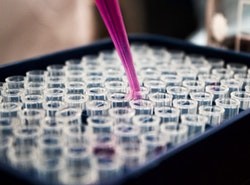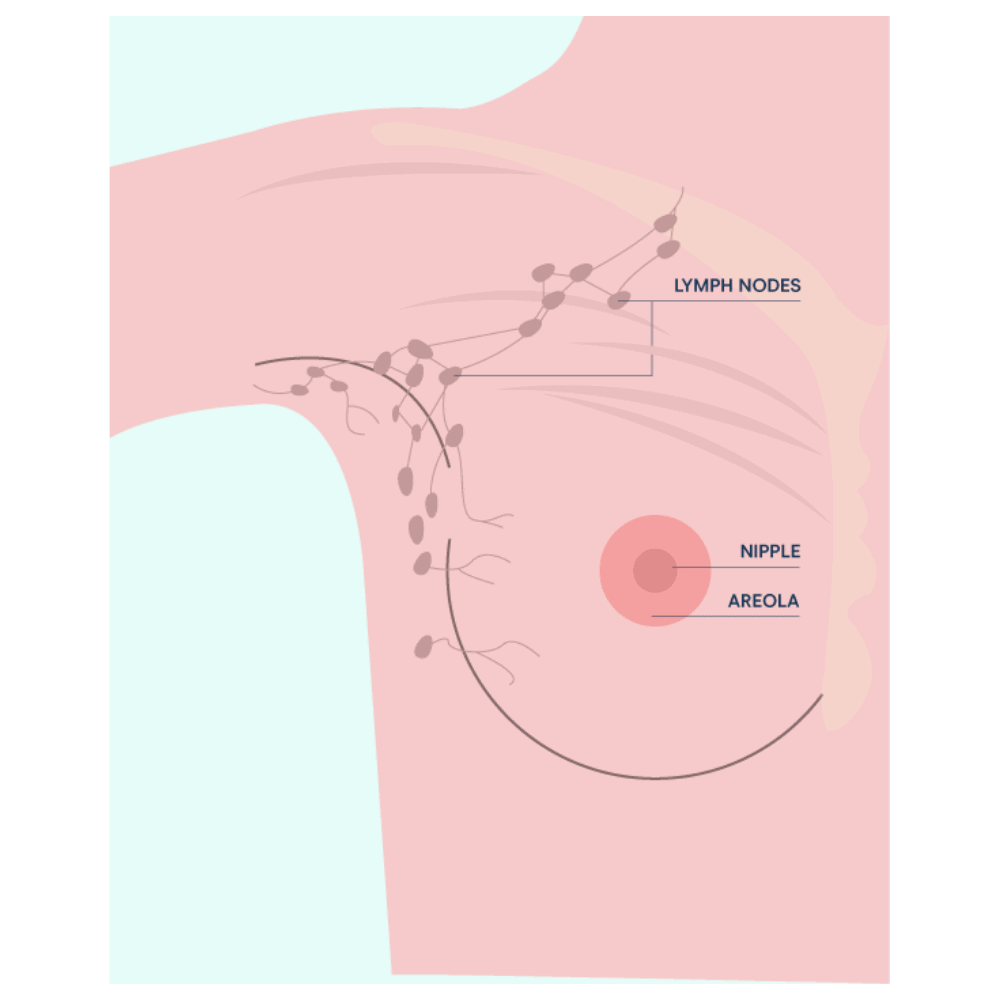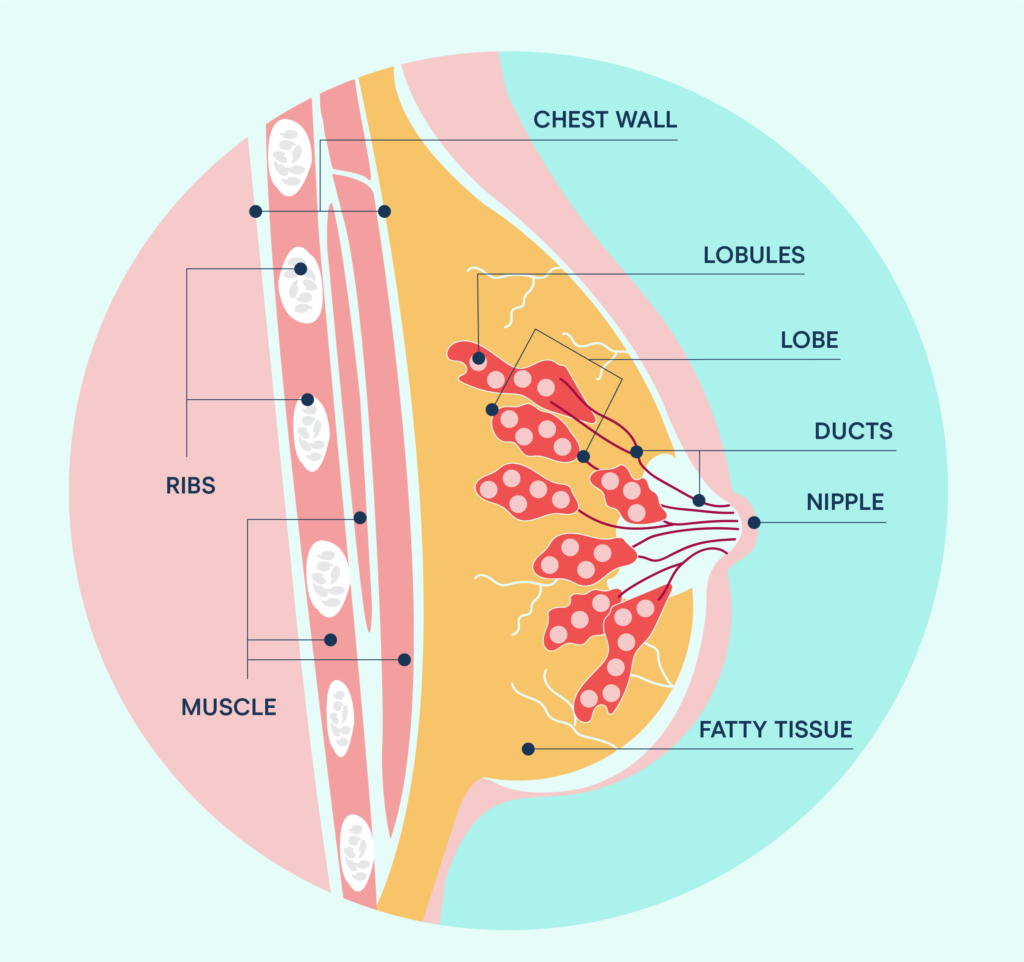
BREAST CANCER ANATOMY AND
HOW BREAST CANCER STARTS
The breast (medically known as the mammary gland) is a highly complex part of the human body. The female breast goes through many changes over a lifetime – from birth, puberty, pregnancy and breastfeeding, right through to menopause.
If you have been diagnosed with breast cancer, understanding the anatomy of the breast and the role each part has to play can be helpful to understand your diagnosis. It can also help you talk to your doctor about surgery and other treatment options.
In this piece we cover:
-Understanding Breast Anatomy
-Normal Breast Changes Through Life
-How Does Cancer Start in the Breast?
-How Does Cancer Spread Beyond the Breast?
-Symptoms of Breast Cancer
Understanding Breast Anatomy
What is a breast made of?
Both men and women have breasts, but women have more breast tissue than men.
The female breast is made of different components, including:
- lobules, which produce breast milk
- ducts, which carry milk to the nipple
- fatty (adipose) tissue and connective (fibrous) tissue, which surround the lobules and ducts.
All breasts contain fatty and fibrous tissue. Lobules can also be referred to as glandular tissue. The male breast has ducts but few or no lobes or lobules.

Breast tissue extends from the collarbone to lower ribs, sternum (breastbone) and armpit.
What are breast lobes and breast ducts?
Each female breast contains 15-20 sections called lobes. Each lobe is made up of many smaller sacs called lobules (milk glands). It is these lobules that produce milk in breastfeeding women. The lobes and lobules are connected to the nipple by tubes called ducts, which carry milk to the nipple. Milk flows through the nipple to the outside during breastfeeding.

What are lymph nodes?
Lymph nodes (also called lymph glands) are small, rounded structures of about 1 mm to 25 mm that are found throughout the body.
The lymph nodes form part of the lymphatic system. The lymphatic system is an important part of the immune system that protects the body from disease and infection. It contains a network of thin tubes called lymph vessels that are found throughout the body. These lymph vessels transport a clear fluid called lymph between the lymph nodes. The lymph nodes filter the lymph to trap or remove substances harmful to the body, such as bacteria or cancer cells. This helps to protect the body from disease or infection. The lymph then passes back to the blood.
The closest lymph nodes to the breast are those in the armpit, which are known as axillary nodes. The axillary nodes drain lymph from nearby tissues, including the breast. There are also lymph nodes under the breastbone (internal mammary nodes) and in the neck (supraclavicular nodes). The number of lymph nodes varies between different people. There are usually about 15-30 lymph nodes in the armpit.
Because the lymph vessels carry lymph away from the breast, in the case of breast cancer, cancer cells can enter the lymph vessels and begin to grow in the lymph nodes. The axillary nodes are often the first place of cancer spread outside the breast. Usually, surgery is used to remove one or more of the axillary nodes to help check for cancer spread. Cancer found in the lymph nodes affects the staging and treatment of breast cancer.
What does a mammogram show?
A mammogram is a test used to examine the inside of the breasts, using a low dose X-ray. A trained clinician (radiographer) can interpret the images to identify any abnormal areas, masses or calcium deposits that may or may not indicate breast cancer. Mammograms performed on women who have no signs or symptoms of breast cancer are called screening mammograms. Mammograms that used to evaluate an abnormal breast symptom (such as a breast lump or a suspicious mass on a screening mammogram) are called diagnostic mammograms.
What are dense breasts?
Breasts contain glandular, connective and fatty tissue. Breast density (or mammographic density) is a term used to describe the different proportions of these tissue types as detected by a mammogram. Dense breasts have relatively high amounts of connective and/or glandular tissue and low amounts of fatty tissue. Only a mammogram can show if a woman has dense breasts. Breast density is not related to how the breasts look, feel, their size or firmness.
On a mammogram, connective or fibrous tissue appears white while fatty tissue appears dark. Because breast cancers also appear white, this may make it more difficult for specialists to identify cancer in women with dense breasts. However, even with dense breasts, a screening mammogram is still the most effective method to detect breast cancer early for women over age 50.
Dense breasts also tend to be more common in younger women or women with a lower body mass index. In addition, breast density tends to decrease as women become older.
Normal Breast Changes Through Life
The female breast will go through various normal changes over the course of a lifetime. Many of these changes are driven by hormones. They can be related to the menstrual cycle, pregnancy or the normal aging process. Most breast changes are not cancer, however, if you do notice an unusual breast change, it is important that you speak with your doctor so that it can be checked as soon as possible.
Normal breast changes throughout life include:
Breast changes during pregnancy
During pregnancy, the breasts go through different changes in preparation for breastfeeding after birth. The areola surrounding the nipple will grow larger and become darker. The lobules (milk glands) of the breast increase in size and number. They also begin to produce milk so a mother can breastfeed her baby.
Effect of hormonal changes on breasts
As women develop from pre-puberty through puberty, pregnancy and to menopause, the breasts will be affected by a variety of fluctuations in hormones.
During puberty, hormones produced by the ovaries (such as oestrogen) cause growth and development of the breast. After puberty, the hormones oestrogen and progesterone will change throughout a woman’s monthly menstrual cycle. This may cause women to have swollen or tender breasts at different times of the month.
During pregnancy the body will produce additional oestrogen and progesterone, which trigger further growth and development of the breast to prepare mothers for breastfeeding.
Around the time of menopause (perimenopause), the ovaries stop producing female hormones including oestrogen. Without oestrogen, the breast tissue decreases in size. After menopause (post-menopause), monthly menstrual periods stop.
How Does Cancer Start In The Breast?
To understand how cancer can originate, it can be helpful to understand how regular cells and tissues function and develop.
Healthy cells are the basic building blocks of all tissues and organs in the body. The body is constantly making new cells to replace worn out tissue or to heal injuries. Normal cells are programmed to grow and divide in an orderly and controlled manner, so that each new cell replaces ones that are lost.
Sometimes cells become abnormal and keep growing. As they grow, they can form a mass or lump called a tumour. However, not all tumours are cancer. Some tumours are benign (noncancerous), which means they tend to grow slowly and usually do not invade surrounding tissue or other parts of the body. Tumours that are malignant (cancerous) have the potential to invade and spread to other parts of the body.
Breast cancer starts when cells in the breast (such as cells lining the ducts and lobules) begin to grow abnormally. These cells have the potential to grow out of control and invade the surrounding tissue. When this occurs, this is called invasive breast cancer. If the cancer cells continue to grow, they may spread beyond the breast to other parts of body, which could become life-threatening.
There are different types of breast conditions which are named after the areas of the breast where they start:
Non-invasive breast conditions
- Ductal carcinoma in situ (DCIS) – abnormal cells in the ducts of the breast, which may develop into invasive breast cancer.
- Lobular carcinoma in situ (LCIS) – abnormal cells in the lobules of the breast, which increases the risk of developing breast cancer.
Invasive breast cancers
- Invasive ductal carcinoma (IDC) – which starts in the ducts and accounts for 80% of breast cancers
- Invasive lobular carcinoma (ILC) – which starts in the lobules and accounts for 10% of breast cancers
There are also other less common types of breast cancer such as inflammatory breast cancer, Paget’s disease of the nipple and metaplastic breast cancer. A small number of cancers also begin in other tissues in the breast, such as sarcomas (cancer of the soft tissue) and lymphomas (cancer of the lymphatic system), although these are not considered breast cancers.
How Does Cancer Spread Beyond the Breast?
Breast cancer can invade through nearby tissue, or spread through the body via the lymphatic system and blood.
- Tissue: the cancer spreads from the original site and grows into nearby areas (often referred to as “invasive”).
- Lymphatic system: breast cancer cells break away from the original site and can enter nearby lymph tubes (vessels), grow in nearby lymph nodes or travel through lymph vessels to other parts of the body.
- Blood: breast cancer cells break away from the original site and can enter and travel through nearby blood vessels to other parts of the body.
Where is the first place breast cancer spreads?
The first place that breast cancer commonly spreads to outside the breast are the lymph nodes in the armpit (axillary nodes). Surgery is usually needed to remove one or more lymph nodes to help check for breast cancer spread. This operation to remove lymph nodes in the armpit is known as axillary surgery.
Breast cancer found in the lymph nodes will impact the breast cancer’s staging, and the treatment plan will often be affected as well.
If cancer is found in the lymph nodes, there is a higher chance that cells have travelled through the lymphatic system and bloodstream to spread (metastasise) to other parts of the body. In this instance, treatment with systemic therapies, such as chemotherapy, is likely to be recommended.
If cancer is found in a large number of axillary nodes, radiotherapy may also be recommended to kill any breast cancer cells that remain in the armpit but cannot be removed by surgery.
Symptoms of Breast Cancer
Although a lump in the breast is a common symptom of breast cancer, not all breast cancers have obvious symptoms. For example, some lumps may be too small to be felt, but can be detected with a screening mammogram or other tests. There are also some benign (non cancerous) conditions that can cause lumps in the breast, such as cysts (a fluid-filled sac in the breast) and fibroadenomas (a breast lump made of fibrous and glandular tissue).
Most breast changes are not caused by cancer. However, it is important to see your doctor if you notice any new lumps or other unusual breast changes as soon as possible. Early detection gives the best chance of survival if you are diagnosed with breast cancer.
Related Research
